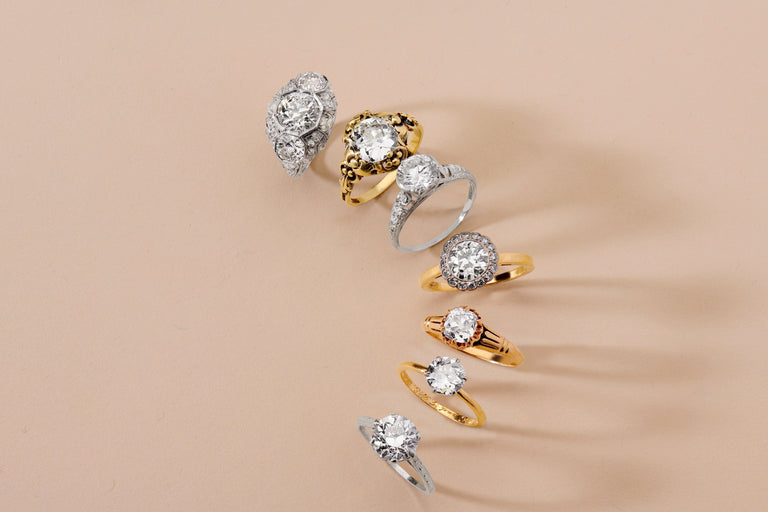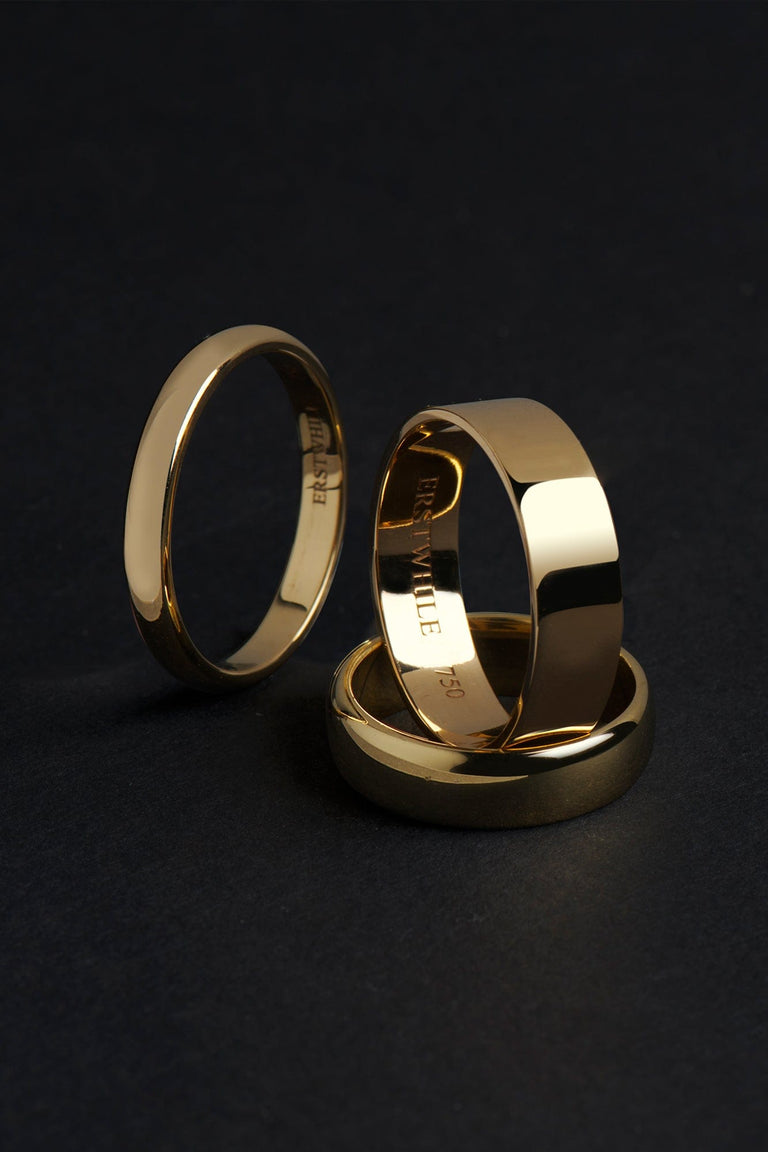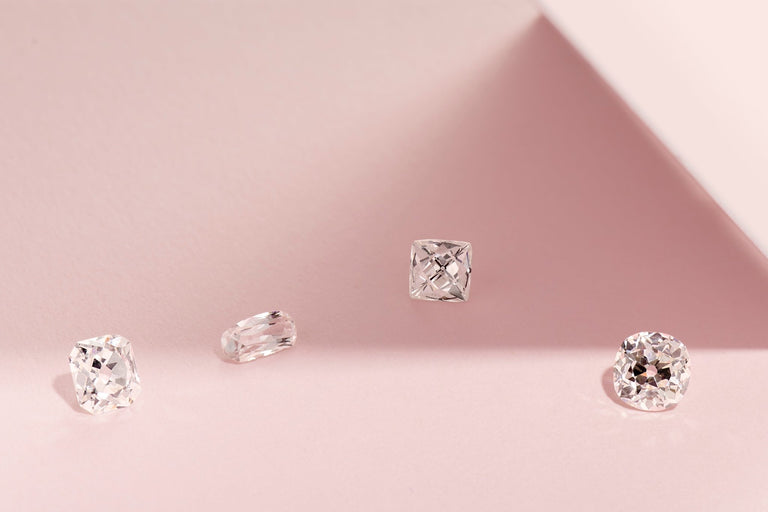Antique and vintage old cut diamonds. You’ve heard of them. You’re intrigued by them. But you don’t understand what they are. Are they better than newly cut stones? Are they more valuable than modern diamonds? What makes them so special?
What is an antique cut diamond? An antique cut diamond may be a diamond cut in an antique style but is actually a modern newly mined stone. Be carful and specific about your needs. If you are looking for an actual antique diamond make sure that is made clear and the stone is called antique not just antique cut. By definition antique describes an object having a high value because of considerable age or belonging to ancient times. Officially in describing jewelry any piece older than 1920 or 100 years old can be deemed antique. An antique diamond would be one cut prior to the 1920s however we group antique and vintage diamonds from the 1930s and 1940s as old cut stones.
What is the oldest cut of diamond? Cut diamonds first made their jewelry debut with the Point and Table Cut diamond in Medieval Islamic rings in the 13th century. Making the Point and Table cut the oldest diamond cuts. Prior the the 17th century diamonds hardly resembled what we have come to think of as a traditional diamond. They looked more like glass or crystals - incredibly charming, but lacking glitter. These included the Table Cut, which has a flat top and 4 corners (like a table), and the Point Cut, which was essentially just a polishing of the rough diamond to reveal the natural curvature of the crystals. By the 16th century, new cuts of diamonds were emerging. Multi faceted Rose Cuts were invented as a glitzier rival to the minimalist Table Cut. Long Rectangular Cut stones, a precursor to the Baguette, were also being cut and were used primarily to form letters and figures. The candlelight dinner parties of the Baroque era demanded something more, and Brilliant Cut diamonds were developed. The first of which is called the Old Mine Cut. These old mine stones were the distant cousin to Modern Brilliant Cut diamonds. They were asymmetrical with uneven facets and were often off round or off square, lying somewhere in between. And they truly sparkled in candlelight, this was before lightbulbs after all. Like a modern brilliant cut, they were pavilion based cuts, with the bulk of the weight in the lower part of the stone. They also have triangular and diamond-shaped facets on both the crown (top) and pavilion (bottom).
What is the difference between an antique and modern diamond? Antique old cut diamonds were not cut with the precision of modern machinery. They are diamond shapes that relied on the precision of the jeweler’s eye. Modern diamonds emerged in the 1950s with the invention of computer assisted diamond cutting techniques which allowed for the standardization of diamond shapes. Every diamond from the mid-20th century on is cut to very precise measurements. The mid-20th century was the delineation between antique and modern diamonds.
What are the different antique diamond cuts? Cut diamonds first made their jewelry debut with Point and Table Cut diamond in Medieval Islamic rings in the 13th century. Prior the the 17th century diamonds hardly resembled what we have come to think of as a traditional diamond. They looked more like glass or crystals - incredibly charming, but lacking glitter.
These included the Table Cut, which has a flat top and 4 corners (like a table), and the Point Cut, which was essentially just a polishing of the rough diamond to reveal the natural curvature of the crystals. By the 16th century, new cuts of diamonds were emerging. Multi faceted Rose Cuts were invented as a glitzier rival to the minimalist Table Cut. Long Rectangular Cut stones, a precursor to the Baguette, were also being cut and were used primarily to form letters and figures.
The candlelight dinner parties of the Baroque era demanded something more, and Brilliant Cut diamonds were developed. The first of which is called the Old Mine Cut.
These old mine stones were the distant cousin to Modern Brilliant Cut diamonds. They were asymmetrical with uneven facets and were often off round or off square, lying somewhere in between. And they truly sparkled in candlelight, this was before lightbulbs after all. Like a modern brilliant cut, they were pavilion based cuts, with the bulk of the weight in the lower part of the stone. They also have triangular and diamond-shaped facets on both the crown (top) and pavilion (bottom).
Let’s dive a little deeper into diamond cuts you will actually come across as you shop. You will likely not see a Point or Table Cut, as most substantial stones from the 16th century have been recut. Any preserved pieces from this time period are quite rare and expensive.
Old Mine Cut - our first Brilliant Cut. They were made with a variety of facet patterns but always with a small table, high crown, and larger culet. These stones are off round - some more than others - with the shape often resembling a pillow cushion.
Old European Cut - The precursor to today’s modern brilliant. Old European cuts have a round girdle, making them appear round from the top view. Like the old mine cut, the old European has a high crown, small table, and open culet. Old Euro facets are much thicker than the facets of their contemporary counterparts, giving them an overall chunkier appearance.
Rose Cut - A flat bottom with a domed, faceted top, this cut is like an “upside down” stone. This cut has no culet and you can see straight through it. If you find an Antique one, grab it! They are hard to find. Rose cuts are still being mined and cut out of India in present day.
Asscher Cut - The cut of the Art Deco era. A classic Asscher cut is a square step cut with cut corners. They have high crowns and small tables, and they carry their weight in their bottoms. Asschers from the 20’s and 30’s are increasingly hard to find.
Emerald Cut - Emerald cut diamonds have a dramatic hall of mirrors effect. Descended from the step cut, emerald cuts were standardized in the 1940s. An old emerald cut will have a larger crown and smaller table. Transitional Cut - not quite old, not quite new. This round diamond is just as the name implies - a transition between the old Euro and the Round Brilliant. They still possess some of the charm of the old Euro, such as a higher crown, but with more precise cutting and therefore more brilliance.
Do old cut diamonds sparkle? Yes old cut diamonds absolutely sparkle. Some more than others. Prior to the invention of electricity, candlelight was the primary source of light at evening events where diamonds were adorned. The stones were cut by candlelight for candlelight viewing. You might notice your antique diamond has an unearthly glow in certain light, especially in the evening.
Antique diamonds were also cut for shape rather than brilliance prior to the old mine diamond. Diamonds like the rose or very first old mine diamonds are least sparkly.
Are antique diamonds more expensive than modern diamonds? As with most things, a diamond's value is inextricably linked to demand. One of the key factors that has influenced antique diamond market price is increased market demand. Over the last 20 years, antique and vintage jewelry has seen a resurgence which has not wained. As diamonds age from 100 years to 120 years old and we move further away from the 20th century, these old cuts will not only become more scarce but also more valuable. As an example, jewelry from the 17th century and older is extremely valuable and rare. The diamonds may not sparkle like the brilliants of today but they hold a value which can not be replicated and has stood the test of time.
Keep in mind that there is a limited supply of antique diamonds and this is one of the key factors that plays into long term worth.
Ultimately, when considering value, don’t forget that the less there is of something, the more valuable it becomes. The value of an antique diamond will only grow over time. Specifically we are seeing Old Mine and Old European cut diamonds selling for the same per carat price as a Modern Cut with the same specs. In some cases, when an old cut diamond is exceptional, it will sell for more than a similar modern stone due to rarity.
What should I look for when buying an old cut antique diamond? Old diamonds are typically warmer in color than new diamonds. They were often found in mines that produced warmer colors. Also, many of the whiter stones have since been recut. What you will typically find are stones that fall in the I-J-K range or warmer. Due to the cut, these often “face up whiter” than a new stone, which tends to be less forgiving. In other words, a K color old stone may read more like a J or even I color, while a J color in a new stone will be visibly warmer. If you are focused on finding a white stone, while they do exist in old stones, they are harder to find and can come at a premium.
Above all else, when shopping vintage consider your personal taste and listen to your heart. Put the certificate aside and focus on what you respond to.
Old cut diamonds are each unique do not look the same as new diamonds, so drop any preconceived notions if you are considering buying old. But you should certainly take a look at the diamond grading report and consider the color and clarity to make sure you are paying fair market value, but things like cut grade and symmetry are much less important.
What are the benefits of buying an old cut antique diamond? They're ethical. Most of us are familiar with the conflict in Africa and blood diamonds. While it is impossible to track what mine any diamond came from, let alone vintage stones, you are using material that is already on the market. Choosing to go vintage, you are eliminating the need for more mining and lessening the demand for new diamonds. They're unique and one-of-kind. Equally important, these diamonds are unique! Each diamond was cut by hand, and the diamond you choose will have a cut that is particular to you, with character unlike any other.
Old cut stones carry the romance of a bygone era. Owning an old diamond is a beautiful way to own a piece of history that will not be repeated. As technology continues to evolve in a world of mass production and we move further away from human made mastery, diamonds and jewelry prior to the 1950s will only become more rare.
Can I buy a new ring with an antique diamond? Yes our newly made namesake Erstwhile collection is set with antique cut diamonds. As well as any made to order setting. Explore our engagement collections set with antique cut diamonds.






